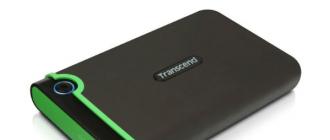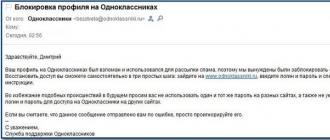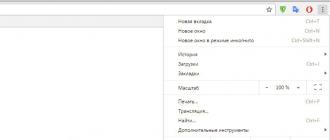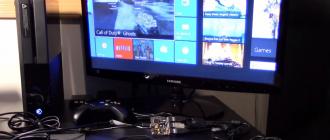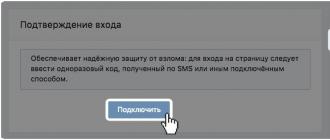Elimination hard faults Disk - a serious lesson, which does not always end in complete success. The matter is further complicated by the fact that in most cases important information is stored on the hard disk, which was not copied to a more reliable place at the right moment.
Not all faults can be eliminated. Thus, the malfunction of the controller, such as the failure of the chip or head failure, at home can not be corrected. In this case, at least knowledge is needed, not to mention the details and tools, and the conditions should be as close as possible to the factory ones. At the same time, with some knowledge and skills, at home you can cope with bad blocks and deal with the data of the system, or, as it is often called, engineering, data field.
Before embarking on the difficult task of troubleshooting, you need to decide in which direction to move. Namely, you need to understand whether you can cope with the malfunction.
The first step is to disconnect from hard drive data loop. Does not interfere also to disconnect the power from installed devices data storage. This will allow you to guaranteed to hear all the sounds made (or not) hard drive when voltage is applied to it.
After turning on the computer, you should listen to the hard disk. Serviceable hDD when power is applied to it, it should unwind, perform initialization and remove the heads from the parking zone. All this usually takes up to 5 seconds. After that, no sounds, except for the sound of the rotation of the discs, should not be. Based on what we heard, we get several basic situations.
- The disk has performed all the necessary actions and is waiting for further instructions. This indicates that at least the disk controller, motors, and heads are in working condition.
- The disc does not spin, and no sounds are heard. This means that there is a malfunction in the hard drive power system (engine damage is also possible). It may be that the power regulator on the controller is damaged or there is a more serious breakdown, for example, most controller nodes have failed. In this case, the engines and heads can remain working. To recommend in this situation is difficult. If you are an experienced radio amateur, have the opportunity, knowledge and conditions, you can try to detect the faulty components and replace them with their counterparts. However, this is a very difficult task, especially if you have to solder and solder the chips. Many controllers cannot be removed from the pallet. This greatly complicates the heating of the desired part of the board to unsolder the desired component. That is why it is best to include such a hard drive in service centerwhere, firstly, they will tell you exactly whether it is subject to repair, and secondly, they will overwrite important information from it.
- The disc spins up, with the rattle heard and there is a strong vibration. This means that a plate block has shifted, or in other words, a disc spindle roll. Such a malfunction in the home does not eliminate. Moreover, such a disk should not even be included, since the plates can be destroyed. In this situation, even the service center, most likely, will not help you, because after an almost impossible alignment of the spindle, the positioning system of the heads will fail due to a violation of the position of the servo-markers.
- The disc is spinning, knocking heard. This can mean a lot, from a faulty positioning system to a head failure. Another option is the appearance of bad blocks in the boot area. This situation you can fix yourself.
The next step is to connect the data loop. In this case, you can not only listen to sounds emitted by the hard disk, but also see various messages and errors during its operation. The following main situations are possible.
- The appearance of messages Tina Invalid Drive Specification. This means that the BIOS contains incorrect information about the parameters of the installed hard drive, or the hard drive is incorrectly recognized. The latter option indicates the destruction of information in the system area of the disk or damage to the heads. It is also possible that the interface contacts are broken both on the controller board and in the data loop itself.
- The appearance of messages like DiskBootFailure. This clearly indicates that the MBR is the master boot record.
- The appearance of messages like BootDiskFiled The most probable cause is the presence of bad blocks on the zero track, which prevents the disk from starting loading.
- The hard disk is recognized normally by both the BIOS and the operating system; however, no disks are visible in the operating system itself. If we exclude the fact that the disk is simply not divided into logical drives, the main reason for this failure is the presence of bad blocks in the system area or destruction file systemcontaining information about the current disk configuration. In this case, either new disk partitioning into logical components with its subsequent formatting can help, or the use of low-level utilities for the purpose of more detailed troubleshooting.
- The hard disk is recognized normally, but the system stops loading or does not boot at all. This fact suggests that on the surface of the disk that stores files operating systemthere are bad blocks. In this case, low-level utilities that can reassign sectors, that is, the so-called REMAP, will most certainly help.
- When you run some applications, periodically there are messages about reading errors. As in the previous case, there are bad blocks on those parts of the disk where their application programs are placed. In this case, check the disk with the subsequent reinstallation of selected applications.
Hard drive malfunctions may be different in nature and manifest themselves in different ways. It all starts with the fact that the operating system increasingly offers to perform a disk check or reports that the work with the system was completed incorrectly. On one “fine” day, the verification program reports “happy” news about the discovery of the first bad block, and a month later you find out that the hard drive acts as a pop drummer, tapping heads rhythmically on the plate surface. This behavior results in the loss of important data and an attempt to repair a hard disk, which, by the way, does not always end successfully. All this can be avoided if the problem is localized in time.
Classify a malfunction of the hard disk can be in several categories:
- logical malfunction;
- malfunction hard controller disk;
- loss or destruction of proprietary information;
- physical malfunction.
Logical fault
With such a fault, booting from the disk is impossible and connecting it to another port of the controller will not have an effect. At the same time, a hard disk with such a malfunction is correctly recognized in the BIOS, and when checking, there are no reports of any physical damage.
Such a disk can not be fixed by all sorts of verification tools like Scandiskincluded in the standard set of operating system utilities. Moreover, the use of such utilities is highly discouraged, since during the verification process they can write to the disk, which can lead to the loss of important information.
This malfunction can be eliminated only by using specialized utilities that at a low level restore partitions and the file structure of the disk.
Hard Disk Controller Malfunction
This category includes physical malfunctions of disk controller components, such as burned-out chips, damaged heads, a torn interface cable, etc. Everything is aggravated by the fact that there are two options for identifying such faults.
The first of these is simple, when an external inspection shows clear signs of destruction - holes in the microcircuits, etc. In this case, before starting any action, the burned components change, if this is possible at all.
The second method is more complicated when there are no obvious signs of damage, but the hard disk behaves differently than it should. The following describes some of these situations.
- The disk drive does not spin up, no sound is heard. If the situation described is observed on the hard disk after a year of power, then the spindle motor may be stuck or the read / write heads “stuck” to the disk surface. In this case, if you try to turn the spindle, you can damage not only the surface of the disk (respectively, the information disappears), but also the mechanism for controlling the heads and the heads themselves.
- The engine does not spin, there is a vibration or a quiet ticking. This situation is a possible continuation of the previous one. In this case, the disk management system assumes that the heads “stuck” to the surface of the disk, and tries to free them by their own methods. She tries to perform emergency unparking of heads using a series of electrical pulses applied to the head positioning unit. As a rule, this action does not bring any results. The most likely reason for this behavior is a failure of the output circuit of the engine rotation generator or a short circuit in the motor winding coil. If a short circuit occurs, it may be accompanied by a strong heating of the controller chips.
- The engine spins up, a click is heard. This click is a result of unparking heads, or rather, its absence. The most likely cause of this failure is the failure of the spindle motor generator or the head positioning system. It is also possible damage to the positioning coil, which is located on the head unit.
- The engine spins up, the disk is not detected or is determined incorrectly. The reasons for the occurrence of such a malfunction can be a failure of the interface chip of the controller or mechanical damage to the contact group to which the data loop is connected, for example, a bent or broken metal terminal.
- After some time, the engine stops spinning, knocking or rattling. This malfunction is due to overheating of the control chips, which were originally manufactured with deviations.
- Periodic knocks are heard. This fault is caused by overheating of the switch, which serves to switch heads and amplify the signal coming from them.
Loss or destruction of proprietary information
This category of hard drive malfunctions is most common. The positive side of such faults is that they are corrected exclusively by program methods, that is, using special low-level utilities. If the task is to simply restore the hard drive, then fixing this kind of problem is quite easy. However, if it is necessary to restore both the hard disk drive's operability and the information on it, you will have to spend considerable time collecting information from practically pieces.
As we said, on hard drive There is a special area where important information is entered. It is so important that its performance completely depends on it. In particular, it contains information about defective and unstable disk sectors. This is the so-called defect table. If the data in this table is subjected to an accidental change, then the controller will simply not know where to write data, but where it is impossible. Moreover, he will not know where the part of the information transferred when a defective block is detected.
The reason for the occurrence of such faults often serve as voltage drops. For example, if at the moment of recording information in the service area power was lost, then it is not known what will be written into it and written to the right place. Very often the cause of such failures is the technology of testing and diagnostics. hard drives S.M.A.R.T., which, when turned on, constantly monitors the status of the hard disk and stores information about it in the service area. That is why this technology is disabled by default in the BIOS.
To manifest malfunctions in this category may be different. Most often it looks like an incorrectly determined hard disk. As a result, the drive switches to safe mode and use the hard drive is possible only in technological mode.
Another common feature is the appearance of messages like PrimaryMasterDiskFailin the very beginning of the computer boot. This usually means that the zero track on the hard disk is damaged.
Physical malfunction
Physical malfunction, at least in the form of bad blocks, is the most common problem when using hard disks on magnetic plates. In addition to bad blocks, there are faults heads, engines, etc.
Bad blocks. Bad blocks are called disk areas - sectors that, for one reason or another, become unsuitable for further use. Nobody is insured against the appearance of bad blocks. Moreover, such blocks are present on the disc plates initially.
The causes of bad blocks can be different. The most frequent are:
- destruction of the magnetic layer of the disk due to manufacturing defects:
- the formation of microrelief due to the loss of its magnetic properties by the magnetic layer;
- malfunction of the control unit heads, which cause mechanical shocks on the plate;
- controller malfunctions;
- damage caused by hitting or dropping the hard disk;
- software crashes.
Bad blocks appear and manifest in different ways. Most often it looks like a write or read error message. Another manifestation is obvious when the surface of the disk is checked by special utilities. In this case, the utility puts a special mark on the block and records information about it in the so-called table of defects.
The basic principle of correcting such a malfunction is the reassignment of sectors, which will be discussed later.
- The displacement of a block of disks as a result of a strong impact or shaking of a hard disk. The result of this shift is the inability to position the heads according to servo information recorded in the system area. The result is the emergence of various kinds of rattling, knocking, etc. "Bring to life" such a hard disk is possible, but not always. If the offset is small, then you can use low-level utilities, however, as a rule, all information on the hard drive disappears.
- The failure of the heads. Head faults are directly related to a fault in the positioning system: a few blows to the surface or a limiter - and the head is faulty. A great influence on the state of the head also has temperature conditionin which she works. Since, due to the design and size of the head, the head is very fragile, all these destructive factors are immediately reflected on it. And since there are many such heads in the modern hard disk, the probability of failure of one of them is quite high.
There is a head breakage in reading or writing errors, which constantly occur during the operation of the operating system. In the worst case, reading or writing in general will become impossible. Another reason for the emergence of a head failure may be a violation of the location of the support on which it is attached. This support, or, as it is often called, the slider, is designed to create conditions conducive to the appearance of an air cushion, with the help of which the head hovers above the surface of the disk. Initially, the slider is mounted in such a way that the bottom of it rubs against the surface of the disk. Over time or as a result of a blow, its lower part can wear out, which will cause it to fall. Accordingly, the head will fall, which can lead not only to damage the working surface of the disk, but also to a head break.
- Failure of engines. This happens quite rarely, but no one is immune from this. This may occur as a result of mechanical factors, such as a loose bearing.
- Scratches on the surface of the disk. Most often there are scratches concentric shape. They are the result of a failure of the positioning system or a head breakage. If there is a scratch, then the information that was in these sectors can not be saved. In addition, the appearance of such scratches indicates the imminent failure of the hard drive, if you do not take urgent measures.
The effects of scratching occur, usually in the form loud noises when removing heads from the parking zone or when reading information from bad sections.
If you have any questions about hard drive faults - leave your comments to this article.
Views: 1415Hard disk is necessary for long-term storage of information. Failed hard drive can lead to unstable computer operation and the loss of important and irreplaceable files.
Problems with hdd may be due to the natural aging of the device. Like any mechanical device, the hard drive has a certain working resource. For example, Seagate is producing hard drives that can withstand up to 50,000 on and off cycles.
Winchester may refuse to work due to overheating. HDD temperature should not rise above 55 degrees. Her check is carried out using special tools. This software is AIDA. If the hard drive has a higher temperature, then additional cooling should be installed. It is worth keeping in mind that low temperature indicators are no less dangerous. It should not be less than 20 degrees.
Even for the hard drive is dangerous increased vibration. Such hard disk problems can lead to bad sectors. There is a problem during the operation of the fans in the video card, the CPU coolers and the power supply. The hard disk should be attached to the case using rubber washers. If possible, choose such video cards where the cooler operates at low revs. It is important to buy the best models of hard drives, where the spindle is fixed not only on the bottom, but also on the top cover.
There may still be hard drive problems due to mechanical damage. The reason is a weak or poor-quality power supply. When the computer is turned on, the actual power consumption of the system is much higher than its normal values. A poor-quality power supply will not have time to correct the voltage in a fairly quick time. To solve this problem, you need to have at least 20% of the power reserve.
Problems with the hard disk can lead to violations of operating rules. This especially applies to laptops and external drives. If the portable drive falls in the on state, it will cause sticking. magnetic heads and spindle curvature. Laptops are used when traveling in transport, and the presence of shaking adversely affects the state of the hard drive. If the manufacturers of the firms report reliability with shocks, then this only applies to the disconnected device, which has parked heads.
The main symptoms of a hard drive failure
Hard disk failures can be divided into the following groups:
- Logical (random formatting, file directory corruption due to virus attack, operating system crashes).
- Mechanical (failure of the control unit, spindle jamming, magnetic heads failure, unreadable sectors, physical wear and tear).
It is important to notice signs of malfunctioning of the hard disk as early as possible so that the equipment does not completely fail. Signs of mechanical faults include:
- Inability to start the operating system.
- Certain sectors are not read or the disk is not visible in BIOS.
- The appearance of a blue screen.
- The appearance of messages.
- Failure of the operating system while writing or reading files.
- Lack of access to documents or their loss.
- Slow work with files.
When hard disk problems are caused by a controller failure, the disk does not make any sounds during system startup and does not vibrate. Files that are on the hard drive are saved, but they are not accessible. If you hear a tapping during operation, this indicates damage to the magnetic heads. The presence of a sharp whistle indicates a malfunction of the spindle. About the presence of bad sectors says the following:
- Slow reading.
- System error messages.
- Malfunctions in Windows.
The logical causes of a hard drive failure are similar to a mechanical failure. But at the same time the disk remains visible in BIOS, and during operation extraneous noise missing.
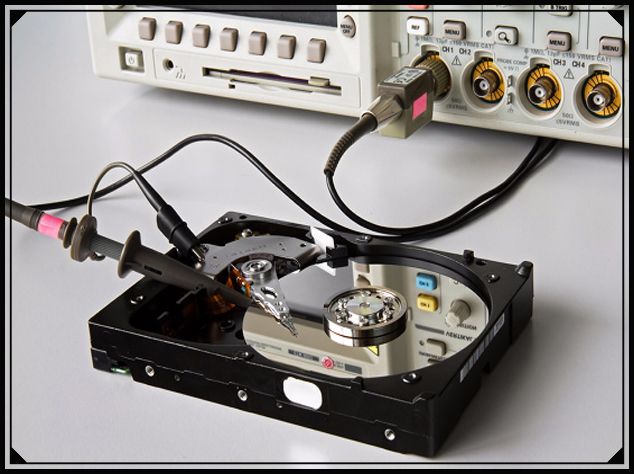
When the first signs of malfunction hdd appear, you need to quickly save the information to the cloud or to backup media. This will be true when the magnetic heads are tapping. Because of a similar problem, the hard drive at any time can fail completely.
After saving all the important information, you need to open the computer case and remove it from the contacts on system board and on the winchester data loops. Then the contacts are cleaned of dust. The process should be carried out carefully, without opening the hard disk case. Winchesters are quite sensitive to dust.
The hard disk may be due to a weak power supply. He simply does not have enough power to work HDD. You can temporarily turn off additional power consumers. Most in a simple way checking the absence of damage to the hard drive will connect it to another computer.
Starts antivirus program and scanned the computer. This is best done using a bootable CD, which is offered by many antivirus manufacturers. Images of such discs are available on the Internet.
Using special programs to check hard conditions disk
If you are using an operating windows system, it is possible to detect hard disk problems in all versions of the OS using the built-in utility:
- The “Properties” of that disk are opened, the correct operation of which is in doubt.
- Go to the tab "Service".
- Select the item "Perform a scan."
If the test results show that there are malfunctions in the hard disk, then you need to quickly replace and restore the data from the saved backup.
Among the software from third-party manufacturers, the Victoria utility has become the most popular. It provides a search for bad sectors, marks them as non-working and tries to recover. For hard checks drive need:
- Mark the hard drive on the first tab.
- Go to the Tests menu.
- Run HDD testing.
If you see rectangles with an access time of 200-600 ms, which are colored green or orange, this means that the hard drive sectors are damaged. It is necessary to select the Remap item so that the utility marks them as non-working. In this case, you will need to replace the hard drive.
Novice users can apply free utility Seagate SeaTools. It has a Russian interface and is available on the manufacturer’s website. A full description of the program is available in the Help section.
There are the following versions of the software:
- Seagate for dos. Has the form boot disk in ISO format. When you boot from it, you can find problems on your hard drive, and then try to fix them. Using this version will help to avoid problems that arise due to the operating system to the disk.
- SeaTools for Windows. Used to work under OS control.
According to statistics hard drives are the least reliable devices in the computer they contain mechanical, software and electronic parts. In our laboratory, all work with the HDD HD block is performed in a special "Clean Room", so the data recovery takes place at a high quality level!
Recovery of information from HDD consists of several main stages:
- Winchester is temporarily repaired, to the point where it can read the information;
- With a semi-working hard drive with the help of a professional software a sector copy is made to another absolutely working HDD;
- Further, if necessary, the logical data structure of the user data is analyzed on a working disk and in case of its damage it is corrected;
- Then the information is recorded in pure form on the customer’s new drive.
- when information is completely overwritten by other information.
- when magnetic disc plates are physically damaged (bent or scratched by heads)
- when the plates are demagnetized using a data destruction system.
- after strong heating (for example, in case of fire), when the temperature reaches the Curie point and the ordering of the magnetic domains is destroyed due to strong thermal oscillations of atoms inside the ferromagnet (the substance of the HDD covering plate).
Logical failures
Consider the reasons and the number of percent attributable to data recovery after logical failures:
- Accidental deletion of files or incorrect formatting of the disk by the user. This usually occurs as a result of erroneous or inept actions. The most common case is when people format a hard disk, reinstall the operating system and a bunch of programs on it, and then they remember that they previously had an archive of documents and photos on this disk. file recovery performed with the help of special software usually allows you to recover most of the information.
- Damage to the disk file system. In this case, the logical disk usually disappears in Explorer or there is no access to it. The reason for this can be many factors: the failure of the operating system, the impact of viruses, incorrect removal of the drive (in the case of portable disks). Very often this happens on Flash cards in cameras, in this case the card asks to format it, of course this is not worth it, and the percentage attributable to the recovery of information in such cases is usually 90-95%.
- Failed to merge or move disk partitions using the program Partition Magic. Not only does this program itself not always successfully complete such operations with moving a large amount of information, they can also turn off the lights in an apartment or office and then all the contents of the disk partitions on which the manipulations were performed become inaccessible. Data recovery allows you to return only part of the information, because at partition Magic is not logged and therefore there is no possibility to roll back.
- Dynamic disks. Periodically there are cases when after reinstall windows users have lost logical markup on hard drive. On such disks there is a binding of the logical structure to a specific operating system, and after reinstalling it, this binding does not give new windows see the logical drives from the old. File recovery allows you to return information to 100%. To do this, you need to transfer all files and folders to another disk with the help of special software, re-create the partition on the old disk and write back all the information to it.
- The so-called LBA 48 problemIt usually arises due to the lack of operating system support for hard drives larger than 137GB. The error lies in the fact that the operating system misunderstanding the disk size of more than 137GB does not continue to write further, but begins to write to the beginning of the disk, thereby erasing it. Support for hard drives larger than 137GB in Windows 2000 and Windows XP is provided only with the appropriate Service Pack installed. Service Pack3 is required for Windows 2000, Service Pack1 for Windows XP. You should not connect a large-capacity marked hard disk to systems that do not have 48bitLBA support, as this will lead to file system corruption and data loss.
Often the cause of computer failures are hard disk problems. In this article, we will learn how to diagnose and eliminate them. Briefly about its internal structure, you can read in the article "".
In general, I must say that hard drive problems - this is just one of possible problems system instability, and they can be quite a lot. But, understand me correctly, if I try to describe them all in one article, then confusion will form in your head and there will be no sense. Therefore, we agree: in this article we deal exclusively hard drive issues, and the following we will talk about the problems random access memory, power supplies, etc.
Winchester can rightfully be considered one of the most unreliable computer nodes, and this is understandable, since it has, on the one hand, a complex mechanical component, and, on the other, electronic control boards. And any mechanics additionally suffers from physical impact (shock, shaking, vibration, etc.).
But how to determine what's wrong with your hard disk (hard drive, hard drive)? Perhaps your computer starts to reboot spontaneously, periodically shows the BSOD screen ( blue screen with white text on it), unexpectedly "freezes" in the process of work? All of these are potential hard drive problems.
In my practice there were cases when, due to the large number of bad sectors on the disk, the operating system did not want to be installed on it. In such cases, a message appears on the screen stating that one or another file cannot be written to disk.
In such a situation, the hard drive must be checked for the presence of so-called (bad blocks). We must immediately say that the trouble blocks are brain teaser and physical. As the name implies, physical distress blocks are formed as a result of physical micro-damage to the magnetic layer of the disk plates.
In this case, we are not talking about restoring such sectors, but rather should consider the issue of saving information to another reliable medium and (in the near future) replacing the damaged one. The fact is that physical troubles blocks (as opposed to logical) tend to increase in quantity. And this is logical, since, being disturbed, the magnetic layer of the disk plates begins to gradually deteriorate.
Hard problems disk associated with the formation of logical trouble blocks can be quite successfully eliminated with the help of special software. And your computer will feel like new again :)
The formation of a logical bad sector is connected with the discrepancy of its checksum with the checksum of the data recorded in this sector. This may be caused, for example, by an unexpected power outage at the time of the write process to disk. The scanning program "clogs" (overwrites) such a sector with zeros, resetting the checksum of its data.
Quite often, in my practice in matters related to hard drive malfunctions, I observed the successful "treatment" of hard drives, which had several dozen logical bad sectors.
There are many different programs that successfully cope with this task. Each of them also has its own, peculiar only to her, "chips" and functions. I would not like to list them all here. In the next article, I’ll tell you about only one of them (I personally use it very often for work). It is very easy to learn and performs its work perfectly.
a few more hard drive problems
What other situations should we be prepared for? First of all, if the computer suddenly freezes, remove the side cover. system unit And listen, are there any clicks or a slight rattle from the hard drive?
The fact is that malfunctions of the control system of the hard disk magnetic head unit often lead to the fact that the read-write heads cannot be positioned correctly and begin to move irregularly above the surface of the plates or “fall” (hit on their surface), creating the same gnash
Also, you should know that in the production of hard disks their surface is divided into tracks and special technical information is put on them - servo marks. According to them, the magnetic heads are oriented, being positioned over a certain sector. Servo tags do not disappear with any type of disk formatting, but they can easily be damaged if the magnetic plate is physically damaged. The result, I think, is obvious and the heads will not be able to position themselves correctly.
This is how the block of magnetic heads looks like, located inside our hard drive.
Let's talk a little about what you should pay attention to in the first place if there are problems with your hard disk: the first - extraneous and uncharacteristic for normal work hard drive sounds emanating from it. At home, repair is not possible, since to replace the BMG (magnetic heads unit), it will be necessary to open the hard drive's containment zone, and the inevitable dust entering it will “kill” the disk. It is very likely that you will need to contact the service center, and most likely you will have to change the hard drive.
The second - excessive overheating of individual parts of the device (controller chips). You can try to cool an overheated area with a small computer fan, which may delay somewhat (sometimes it took more than six months) to inevitably complete equipment failure, but changing the hard disk sooner or later will have to do it, because during long-term work in high temperatures, internal burnout components simply inevitable.
Let's look at an example: we had one hard dick at work (he is still in the drawer of my desk), the malfunction of which led to regular computer hangs about twenty minutes after its launch. Naturally, the first thing we checked it for the presence of bad sectors (trouble blocks). They did not appear, other programs for surface diagnostics also revealed no problems.
But another interesting thing came to light: one of the disk controller elements obviously overheated against the background of the other microcircuits.
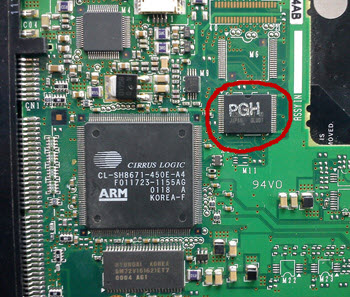
Normal for a hard disk is considered the temperature to 40 degrees Celsius. The painful threshold of a person (when one wants to withdraw a hand from something hot) is about 55 degrees. So, after ten minutes of work, the chip heated up to a temperature, when I wanted to withdraw my hand, after another ten minutes - the computer was hanging tight.
The external fan decided not to use (since a spare hard drive was available), but keep this option in mind with the hard drive problem.
I would like to say a few words about the controller board itself. It is located on the back of the disk and looks like this:

The controller is a complex device (simply - a minicomputer, with its own microprocessor, a certain amount of RAM, cache, input-output operations, etc.). He is fully responsible for sending information from the read / write heads to the external interface of the hard disk (“IDE” or “SATA” connector).
With this photo above, I want to immediately "kill" two birds with one stone: show you what the controller circuit looks like and hint at what happens when the system logic chips overheat for a long time :) As you can see, part of the chip just collapsed. In specialized repair shops, such problems of the hard disk are eliminated by a complete replacement of the controller board. In principle, this can be done on your own, but it is necessary to take into account the fact that the donor disk should be absolutely identical the one to which the replaced board is being transferred, otherwise you can only aggravate the situation with data recovery from it.
Note: When any element burns out on the controller, the situation will not necessarily look so tragic! The photo above is rather an exception. But putting a palm (in case of malfunction of the hard drive) on the controller when the PC is running is the first thing! See if something is overheating on it?
Normal (safe) disk operation temperature is up to forty degrees Celsius (a little higher - also not a problem). But if the temperature of individual elements of the drive passes for 50-55, be prepared for the troubles that will certainly follow: irreversible changes (degradation) of elements located on the disk controller board may begin.
Unfortunately, business can not be limited to one replacement of a payment. The fact is that each controller has its own software "firmware" in the service area of the disk (utility), which, when the system boots, reports BIOS information about the main drive (number of sectors, heads, cylinders, etc.). If we simply replace the board without replacing the "sluzhku", we will not achieve the result, so it is recommended to do this procedure in specialized service centers.
Let's take a closer look at this moment!
Third a typical case of a hard disk failure: after the engine tries to unwind the magnetic plates and after a while it stops and repeats with equal intervals of time. This problem can be easily identified by putting a palm on the top cover of a working hard drive. You will definitely feel the moment of unwinding and stopping the motor. Repair hardly makes sense - the disk must be replaced.
I also want to note that hard disk problems can also be caused by problems with the interface cable transferring data from the controller to the disk. I remember, we had a case: the computer periodically “hung”, gave out a “blue screen of death” (BSOD) and spontaneously rebooted. It turned out that the reason was the broken retainer of the SATA interface cable,
![]()
which had bad electrical contact from the hard disk and therefore caused all these problems. We replaced the cable - the problem disappeared.
At the end of the article I would like to dwell on such technology as “S.M.A.R.T.” (eng. self-monitoring, analysis and reporting technology) - technology monitoring, introspection and reporting. Evaluation of the overall condition of the hard disk in many ways, with the aim of predictions time of its failure.
"S.M.A.R.T." appeared in the early 90s of the last century and, over time, "overgrown" with a large number of measured and observed parameters that help prevent hard drive problems. Indicators of the state of "health" of the disk are read by the program and displayed in a user-friendly form. Based on these data, we can conclude: how much is our device "left"? :)
For example, here’s what the program status window looks like. Hddhealth”, Which we reviewed one of our disks (Seagate 250 GB), which issued a warning about the deteriorated parameters“ S.M.A.R.T. ”when the operating system was loaded.
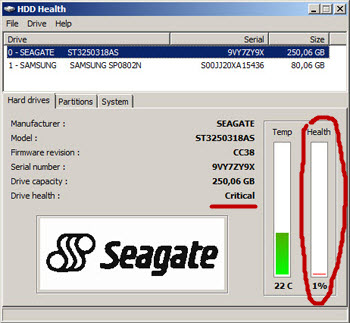
Pay attention to the selected areas in the screenshot above. The “Health” indicator is 1%. As the saying goes, “comments are unnecessary”, the device may leave us at any time :) The “Temp” value shows us the current temperature of the hard disk.
If you enter the “Drive” menu and select the “SMART Atributes” option from the menu that opens, you can view the entire list of monitored hard drive parameters:
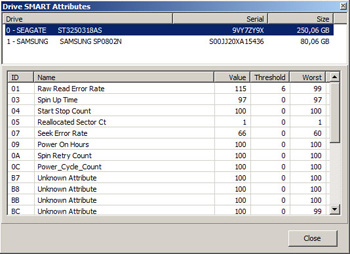
Factory setting parameter " Value"(English. -" value ") usually have initial parameters 100, 200 or 250. The larger the value, the better. High values indicate no change or slow deterioration of this parameter. " Treshold"- the threshold value (value, ideally, should not come close or fall below it). " Worst"- the minimum figure that the system demonstrated during testing and measurement.
The critical parameters that lead to hard drive problems are:
- Raw Read Error Rate and Seek Error Rate - wear magnetic surface or heads BMG
- Spin-Up Time and Spin-Up Retry Count - problems in mechanics
- Reallocated Sectors Count, Reallocation Event Count and Current Pending Sector Count, Uncorrectable - the presence of bad sectors, already moved bad sectors and ready to move
The "HddHealth" program you can.
Below I want to bring to your attention the recorded sounds of hard disk problems emitted by products from different manufacturers. Perhaps this compilation will help orient your hearing when diagnosing a malfunction?
The operation of the IBM hard drive (standard)
|
|
| Contact disturbance between controller and HDA | |
| IBM hard drive knocks with BMG malfunction | |
| Knock the hard drive Seagate with a faulty BMG | |
| Sounds from a fully functional Seagate disc | |
| Fully serviceable Fujitsu | |
| Knocking a Fujitsu disc with a malfunction BMG | |
| Knocking disc Quantum with non-working BMG | |
| Maxtor Disk with the same problem | |
| Sometimes it happens:) | |
| Grating bmg in Western digital (WD) | |
| Samsung tapping | |
| Fully working Samsung hard drive |
Unfortunately, the error 301, which at the start of the computer system fails to initialize the hard disk, is a serious problem, and for some reason it is found mostly on HP laptops. Of course, the appearance of this failure may indicate the beginning of the failure of the hard drive, but in some cases the error can be fixed without hard replace disk.
HP Notebook: Error 301. What does it mean?
So, before proceeding to the immediate solution of the problem, you need to find out what its essence is.
A hard disk drive 301 error indicates that so-called bad sectors are present on the hard drive itself, which is why the system starts to catastrophically slow down and freeze when accessing them, sometimes even producing a blue screen. But this only concerns the mode of operation when the OS is already loaded.
When the OS starts, after checking the hardware in the BIOS, when it loads the components necessary for its operation, accessing the bad sectors in the same way results in the fact that the system cannot read information from them. At first, as evidenced by reviews from many users, you can get used to the constant appearance of the message when downloading. But it is possible that the 301 error will later prove to be fatal when an old hard drive will just have to be thrown away. Therefore, it must be fought.
Causes of failure and its consequences
But, regardless of how to fix the error 301, all owners of HP laptops are primarily interested in the question of why bad sectors appear on the hard disk.
An unequivocal answer is impossible. But most often this is due to errors on the hard drive, which usually appear due to incorrect operation of the cooling system.

There are cases when the processor temperature when trying to access bad sectors reached about 90 degrees Celsius. It is not difficult to guess that if the elimination of this failure is left to chance, it can go as far as the processor and motherboard will fail.
Disk check
Now directly how the error of a hard disk 301 is eliminated. First of all in the working system it is necessary to check it for existence broken sectorsusing the standard system tool in the properties of the main and virtual sections on the service tab. It is desirable to specify the automatic correction of errors.
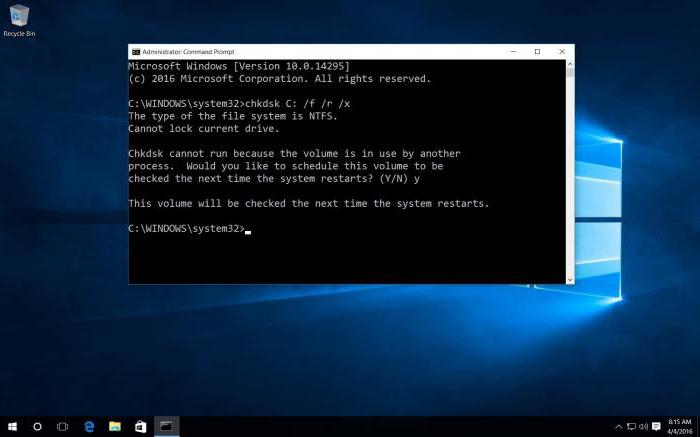
But this method may not work, so it’s best to use the command console with chkdsk with additional parameters like / x / f / r. If this does not give the desired effect, you can try to boot from the installation or recovery disk, and then perform a similar operation in command linecaused by Shift + F10. If the system denies access or attempts to initialize, you will be asked to check on the next start of the OS. It remains to restart the laptop and wait for the end of the procedure.
Using the Victoria program
However reveal all bad sectors The above technique can not. The main remedy for the problem, when the error code 301 appears, is to isolate the bad sectors if not corrected, if the hard drive began to crumble.
At the first stage, this will have to sacrifice space, about 5-15% of the total. But after all it is required to reveal from which sector the braking begins.
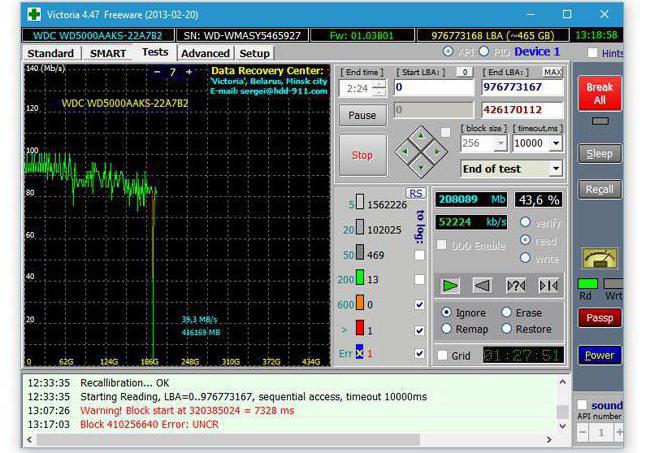
To do this, use the universal program Victoria. In its results and statistics of hard disk accesses, it will be possible to find out the exact amount that will have to be cut off so that the system simply does not turn to them in the future. By the way, quite often you can find reviews that the error is associated more with virtual partitions, and not with the system one.
Deleting and re-creating a virtual partition
Now, to answer the question of how to fix the error 301 of the hard disk, the virtual partition needs to be deleted, and then re-created, taking into account the minus of the volume that the Victoria program revealed.
Please note that if there are failures not in the system partition, you can format the virtual disk, but to avoid losing information on the main disk where the system is installed, this is not the case.
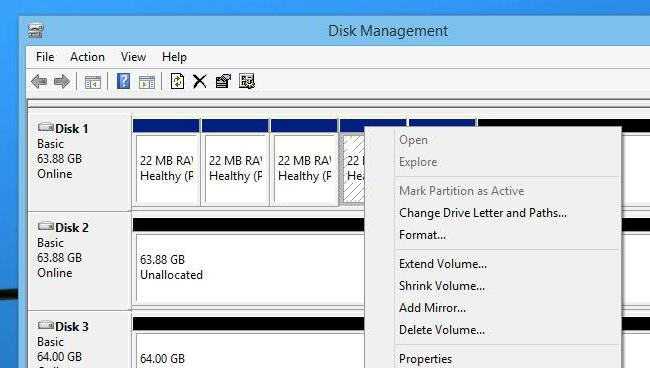
You can perform such operations in the disk management section, which is located in the management (administration) menu, called via PCM on the computer icon. By the way, in Windows 10 it is located in “Explorer”, and not on the “Desktop”.

After this, it is necessary to create a new volume (simple virtual partition), again taking into account the deduction of the previously defined space, and to initialize and activate it.
Disable the paging file
Another method that sometimes eliminates error 301 is to disable paging files for both system and virtual partitions, because when virtual memory is enabled, the system accesses the pagefile.sys file, but it can either be located in an area with bad sectors, or reserve this area in the failed section.

To disconnect via PCM, the system properties menu is called up on the computer's icon, the transition to the advanced settings and the tab of the same name are made. Here you should use the button for changing the size of the paging file, remove the check mark from its automatic detection and set a tick on the deactivation line of its use. This operation is performed for each section presented in the list above.
Defragmentation
Finally, when all actions are performed, so that error 301 will probably no longer appear again, it is necessary to defragment the system partition and all virtual partitions.
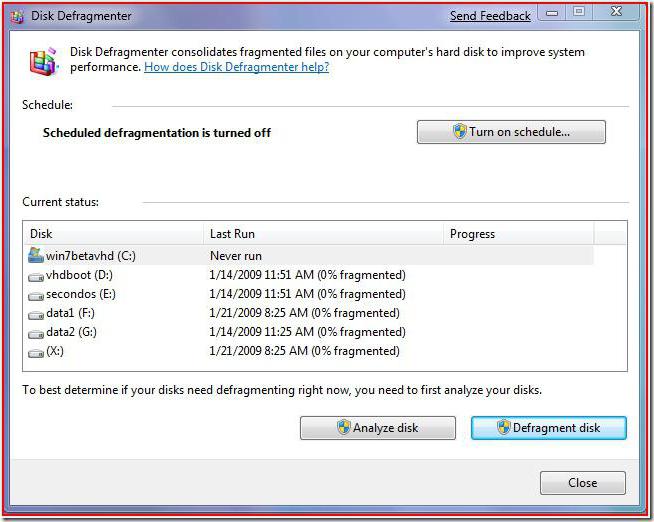
This operation can be performed using standard tools of Windows systems, which can be accessed on the service tab from the disk properties section.
Provided that in the system any program can be used for optimization and acceleration, the maintenance (defragmentation) command can be integrated directly into the “Explorer” menu. I must say that the defragmenter in such utilities looks much more preferable than the built-in Windows tool. Therefore, if there is such an opportunity, it is better to give preference to optimizers (they use a slightly different principle of restoring order in the system, and in particular on the hard disk).
Upon completion of the entire set of actions, as a control tool, you can run the same Victoria utility and perform a check. As practice shows, in 99% of 100 out of 100 “cut off” bad sectors will be ignored, and the test will not reveal any errors.
Instead of the total
As can be seen from the above material, to eliminate the error code 301 can be quite simple. True, it must be borne in mind here that its appearance is the first bell about the fact that the hard drive has started to crumble and will soon have to be changed after first copying the most important information to removable media or even another hard drive. To avoid reinstalling the system, you can create its image with all the data and place, for example, on external drive USB HDD. This option looks much more efficient than copying individual files and directories to flash drives, even if they are large enough. Anyway, according to the time spent, it will take longer.
In the extreme case, if nothing helps at all, you can use a unique hard disk reversal program called But for an ordinary user, it will be too complicated to understand and use, besides, the lack of a Russified interface will make it difficult and work only in DOS mode.

